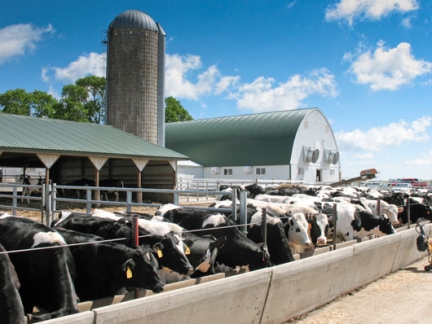
The MPCA regulates most aspects of livestock management including the location, design, construction, operation, and management of feedlots and manure handling facilities. The primary concerns in feedlot regulation:
- Manure from a feedlot or manure storage area does not run into water
- Nutrient-rich manure is applied to cropland using practices that prevent contamination of streams, lakes, and groundwater
Nearly all feedlot owners are required to register with the state, though most small feedlots do not require permits except for construction or expansion activities. The estimated 18,000 registered livestock feedlots in Minnesota range from small farms to large-scale operations. About 1,200 large feedlots in Minnesota operate with state and federal permits; generally, a large feedlot has 1,000 or more animal units.
The MPCA also conducts inspections at feedlots to be certain they comply with environmental requirements, properly contain manure, and have adequate manure management plans. Staff focus on feedlots and manure storage areas that have the greatest potential for environmental impact.
Delegated county program
In most of Minnesota’s livestock-dense counties, feedlot oversight is a cooperative effort between the MPCA and county government. A county feedlot officer (CFO) performs registration, permitting, inspections, assistance, and complaint follow-up for most facilities with fewer than 1,000 animal units, on behalf of the MPCA.
Current challenges in feedlot regulation
Agriculture is a major portion of the state’s economy, and many residents rely on products from livestock facilities, such as eggs, butter, milk, and meat. But livestock production generates manure, which must be managed in an environmentally responsible manner. Some of the larger challenges in regulating feedlots include:
Nitrate. Manure is a natural source of nitrogen and can be an effective fertilizer for cropland. But manure can contain nitrate, a form of nitrogen that contaminates ground and surface waters. Planting cover crops can minimize nitrate leaching for summer and early fall manure applications. Delaying manure application in the fall until soil temperatures are 50°F or less (typically around Oct. 15) can also reduce nitrate pollution.
Manure-contaminated runoff. Spreading manure on cropland is most effective when it's applied at the time the crop needs it. Many smaller farms lack the resources to build long-term manure storage structures so they can hold the manure until application conditions are optimal. The manure may be applied when it can contaminate runoff into lakes or streams, fueling algae growth and even causing fish kills. Increasingly frequent and intense storms compound these risks.
Odors. Livestock odor is caused when organic matter such as manure decomposes and releases gases containing chemicals such as ammonia and hydrogen sulfide. Hydrogen sulfide is detectable at a very tiny amount (1 part per billion), but the nose desensitizes quickly to the odor. That's a concern, since more than 50 parts per billion of hydrogen sulfide can cause headaches, nausea, vomiting, and diarrhea.
The MPCA does not regulate odor in general, but a livestock operation is violating a state standard if its hydrogen sulfide emissions exceed a 30-minute average of 30 parts per billion twice in five days or a 30-minute average of 50 parts per billion twice per year. MPCA staff initially use hand-held monitors to measure hydrogen sulfide levels. When readings are above the state standard, we contact the feedlot owner so they can take steps to fix the problem.